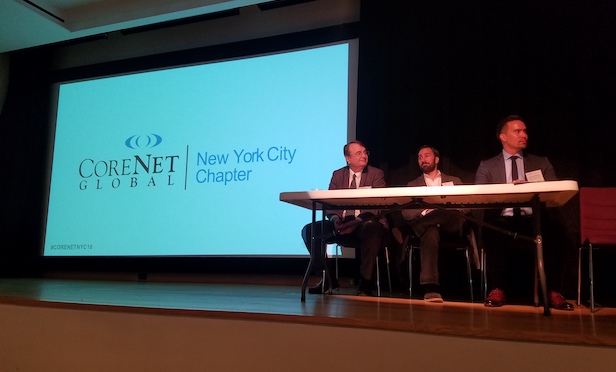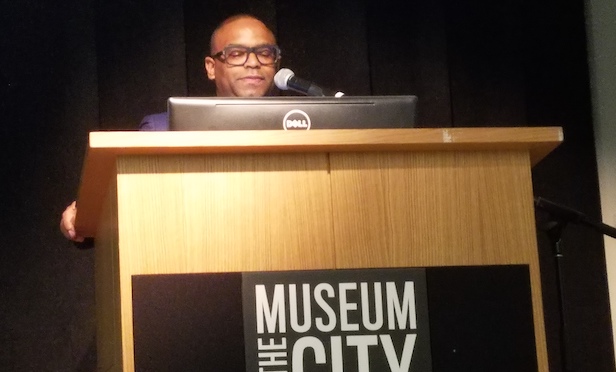 CoreNet event on affordable housing at the Museum of the City of New York/ Photo by Betsy Kim
CoreNet event on affordable housing at the Museum of the City of New York/ Photo by Betsy Kim
NEW YORK CITY—Determining New York City's character, makeup and future depends upon real estate because that's the physical reality, the stage where the city comes to life as a continually evolving experiment.
Mayor Bill de Blasio and others have criticized the city's lack of affordable housing as a growing crisis, referencing Charles Dickens' A Tale of Two Cities. But it's not about REBNY versus tenant advocates, said Matthew Gross, the managing director at Urban Builders Collaborative and executive officer at Lettire Construction Corporation. He spoke on the panel organized by CoreNET at the Museum of the City of New York in East Harlem.
New York City can have a booming economy, which also benefits from the city's cultural and economic diversity.
 Henry Flores, global real estate manager at WarnerMedia and vice chair of CB 11 housing committee/ Photo by Betsy Kim
Henry Flores, global real estate manager at WarnerMedia and vice chair of CB 11 housing committee/ Photo by Betsy KimHowever the waitlist for affordable housing is growing exponentially while subsidies that support such housing are set to expire, said panel moderator, Henry Flores, global real estate manager at WarnerMedia, and vice chair of community board 11 which covers East Harlem. Both he and moderator Xavier Santiago, vice chair of CB 11, described how their families moved to New York, worked hard, saved money and lived in affordable housing.
“Affordable housing is crucial to the success of a community, and bridging the gap of the socio-economic divide,” said Santiago. “However, in this neighborhood and others in New York we face a dearth of affordable housing and the rungs are being pulled out from the ladder.”
 Xavier Santiago, vice chair CB 11/ Photo by Betsy Kim
Xavier Santiago, vice chair CB 11/ Photo by Betsy KimPanelist Jeremiah Schlotman, a staff attorney with the Legal Aid Society, chairs the CB 11 housing committee. He stated the majority of constituents in CB 11 are in the extremely low income range which means earning zero to 30% of Area Media Income, or very low income range which means 31% to 50% of AMI. East Harlem has the largest concentration of rent-regulated housing anywhere in the city at 75% including NYCHA units, according to the Department of Housing and Preservation Development's 2017 East Harlem Housing Plan.
Schlotman noted many of the Section 8 units are not permanently protected as affordable housing, with 40.3% scheduled to expire from the program by 2033.
“New York City shelters have over 61,000 individuals living in them. That does not account for countless others living on the streets,” said Schlotman. He added the city spent $1.8 billion dollars on shelters. Plus, 44% of New York City households are rent burdened defined as spending more than 30% of gross monthly income on rent. Of this 44%, 50% are severely rent burdened paying over 50% of their income towards rent.
 From left: George M. Janes, Matthew Gross, Jeremiah Schlotman/ Photo by Betsy Kim
From left: George M. Janes, Matthew Gross, Jeremiah Schlotman/ Photo by Betsy KimSchlotman also noted the city has nearly one million households under 200% of the federal poverty line, meaning earning roughly $40,000 per year for a family of three. Of these one million households, 29% have some form of public housing support but 53% are paying market-rate or rent-stabilized or rent-controlled rates.
Mayor Bill de Blasio's Housing New York program aspires to create or preserve 300,000 affordable units by 2026. “But we have 368,000 households that are at or below 200% of the federal poverty line. Of those 300,000 that the mayor wants to create or preserve, the majority of them, 56%, are geared towards those between 51% and 80% of AMI. So, we are leaving behind the extremely low and low income folks,” he commented.
Schlotman opined that rent stabilization is the most important tool in protecting affordable housing. With the last elections changing the New York State Senate, he predicted tenant advocates would seek stronger rent stabilization laws.
Gross reviewed structuring and financing for affordable housing deals. One of his developments at 138th Street and Third Avenue in South Bronx is an inclusionary housing project which is 100% affordable. The 130,000 square foot, 96-unit complex with ground floor retail took five years from the date of acquiring the property to break ground. This project required 10 different sources of funding. But Gross has developed projects, cobbling together 15 funding sources or more.
Panelist George M. Janes, who owns a planning law firm with expertise in zoning, summarized the East Harlem zoning. Last year, the City Council unanimously approved rezoning a 96-block area from E. 106th Street to E. 138th Street. Janes said this will significantly increase residential density. The zoning requires mandatory inclusionary housing that attaches to constructing new developments as part of the deed restriction. Thus, it will create permanently affordable units.
However, Janes noted the developer has the option of creating the mandatory inclusionary affordable housing elsewhere—outside of the building. Off-site compliance comes with penalties, such as a 5% increase in the number of required affordable housing units.
Although the zoning will result in additional money, services and public benefits invested in the neighborhood, Schlotman stated the zoning would result in increased displacement pressures. He anticipates this would include landlords trying to push out rent stabilized tenants.
The panelists encouraged anyone concerned about East Harlem's affordable housing to participate in CB 11's housing committee meetings. They convene the first Tuesdays of every month at 6:30 pm at the board office, located at 1664 Park Ave.
© Touchpoint Markets, All Rights Reserved. Request academic re-use from www.copyright.com. All other uses, submit a request to [email protected]. For more inforrmation visit Asset & Logo Licensing.







